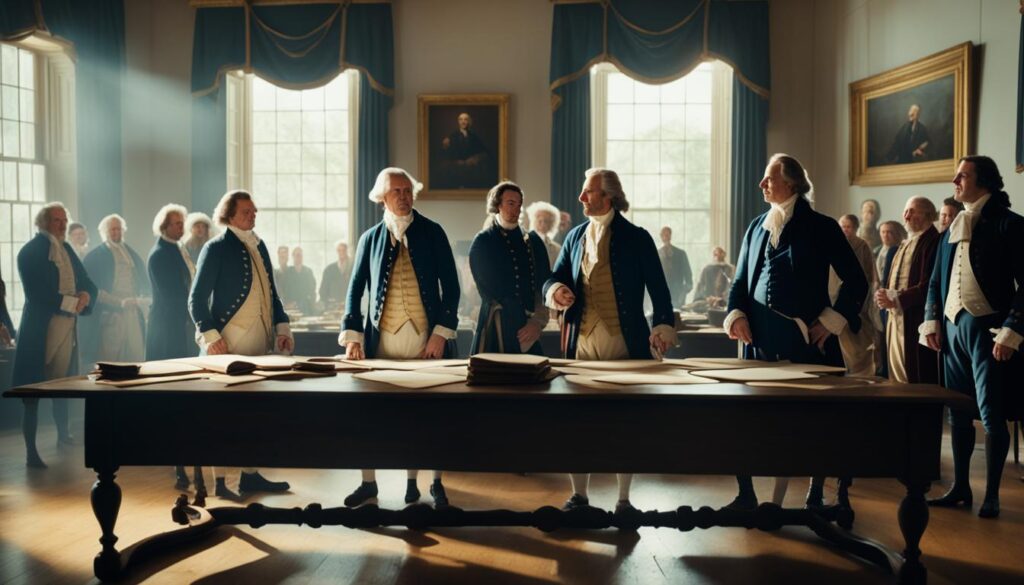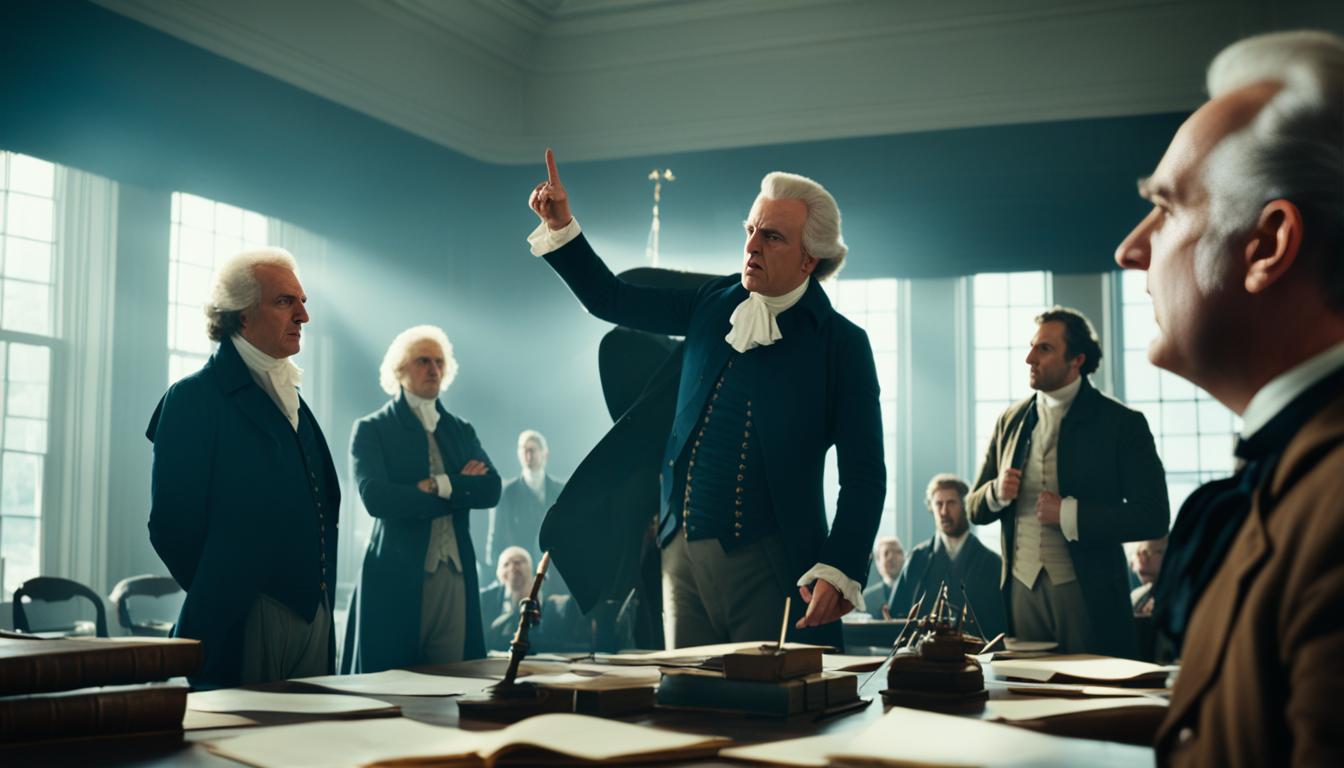The Continental Congress took a bold step on July 2, 1776, voting for independence from Great Britain. This date marks the true birth of the United States as a sovereign nation. John Adams, a key figure in the American Revolution, believed July 2 would be celebrated with fireworks and festivities for generations to come.
While the written Declaration of Independence bears the date July 4, it wasn’t signed until August 2. The document’s journey through history is as fascinating as its content. Fifty-six brave delegates eventually put their names to this revolutionary text, though not all were present on the day of signing.
The Declaration of Independence stands as a testament to the courage and vision of the founding fathers. Its creation and adoption set the stage for the birth of a new nation, forever changing the course of world history.
The True Date of American Independence
July 2, 1776, marks the true date of American independence. On this day, the Second Continental Congress took a monumental step by officially voting to separate the 13 American colonies from British rule. This pivotal moment saw 12 out of 13 colonies approving the motion for independence, setting the stage for the birth of a new nation.
John Adams, a key figure in the Continental Congress, predicted the significance of this date. In his writings, Adams noted that July 2 would be remembered in American history and celebrated with great fanfare. He envisioned festivities, parades, and joyous commemorations marking this momentous occasion for generations to come.
Despite Adams’ prediction, July 4 became the widely recognized Independence Day. This date marks the adoption of the Declaration of Independence by the Continental Congress. The document, primarily authored by Thomas Jefferson, put into words the ideals and principles that would shape the new nation. While July 4 gained prominence, it’s crucial to remember that the Continental Congress vote on July 2 was the true catalyst for American independence.
The Journey of the Declaration of Independence
The Declaration of Independence embarked on a remarkable journey after its adoption. Initially filed in Philadelphia, the document didn’t stay put for long. As the Revolutionary War raged on, the Continental Congress moved the Declaration to Baltimore in December 1776 to safeguard it from British forces.
By March 1777, the precious document returned to Philadelphia. It continued to travel with the Continental Congress, mirroring the nomadic nature of the young government. In 1800, the Declaration found a new home in Washington D.C., the newly established capital of the United States.
https://www.youtube.com/watch?v=Clii4wCFHM0
The War of 1812 brought new threats, prompting officials to move the Declaration to Virginia for protection. The document’s travels didn’t end there. It made a special trip to Philadelphia for the nation’s Centennial celebrations, allowing citizens to marvel at this symbol of American independence.
During World War II, the Declaration took an unexpected detour. With fears of enemy attacks on Washington D.C., officials secretly transported it to Fort Knox. This Kentucky fortress, known for its impenetrable security, kept the Declaration safe until the war’s end.
The Drafting Process of the Declaration
The creation of the Declaration of Independence was a meticulous process that began on June 11, 1776. Thomas Jefferson, tasked with writing the first draft, worked in isolation for over two weeks. His initial version laid the foundation for what would become one of the most influential documents in world history.
Once Jefferson completed his draft, it underwent an intensive editing process. John Adams and Benjamin Franklin, as part of the Committee of Five, played crucial roles in refining the text. They suggested changes and additions, which Jefferson incorporated into the document. This collaborative effort ensured that the Declaration accurately represented the colonies’ grievances and aspirations.
The editing process continued until June 28, when the committee presented the revised draft to the Continental Congress. The document listed 27 colonial grievances against King George III, justifying the break from British rule. On July 4, 1776, after further debate and modifications, the Congress officially adopted the Declaration of Independence, marking a pivotal moment in American history.
Signing Ceremony: Myths and Facts
The signing of the Declaration of Independence is shrouded in myth. Contrary to popular belief, the document wasn’t signed on July 4. The official signing ceremony took place on August 2, 1776. On this day, John Hancock made his mark with a large signature in the center of the document.
State delegations signed the Declaration in a specific order, starting from New Hampshire and ending with Georgia. This process wasn’t completed in a single day. In fact, Thomas McKean of Delaware is believed to be the last person to sign, possibly after January 1777.

The truth about the signing remained hidden until 1884 when historian Mellon Chamberlain uncovered the details of the ceremony. This discovery dispelled the myth that all delegates signed on July 4. In reality, most delegates put pen to paper on August 2, 1776, when a clean copy was finally ready.
The signing ceremony wasn’t a grand event as often portrayed. It was a solemn occasion where delegates from each state took turns adding their names to the document. This act of signing solidified their commitment to independence and marked a pivotal moment in American history.
Key Figures in the Declaration’s Creation
The Declaration of Independence was born from the minds of brilliant men who shaped America’s future. Thomas Jefferson, the primary author, penned the draft between June 11 and 28, 1776. His words captured the spirit of a nation yearning for freedom.
John Adams and Benjamin Franklin played crucial roles in editing the document. Their wisdom and experience helped refine Jefferson’s work, ensuring its impact would resonate for generations. The “Committee of Five” included these three along with Robert Livingston and Roger Sherman.
John Hancock, as President of the Continental Congress, left his mark in history. His bold signature, the first on the document, became synonymous with courage and defiance. On August 2, 1776, Hancock and 55 other brave souls signed their names, risking everything for liberty.
The journey to independence was not easy. On July 2, 1776, 12 out of 13 colonies voted for separation from Great Britain. Two days later, on July 4, the Declaration was adopted, setting the stage for a new nation. These key figures turned ideas into action, forever changing the course of history.
The Declaration’s Physical Journey Across America
The Declaration of Independence embarked on a remarkable journey across America, facing various transportation methods and historical events. Initially stored in a rolled format, this precious document traveled with the Continental Congress by light wagon and horseback. These early trips ensured its preservation during critical times in the nation’s formation.
As the young country grew, so did the Declaration’s travels. When moved to Washington, it journeyed by boat, showcasing the diverse transportation methods used to protect this vital piece of history. The document’s safety remained a top priority, especially during significant historical events.

World War II marked a pivotal moment in the Declaration’s journey. To safeguard it from potential threats, officials transported it by Pullman train to Fort Knox. This wartime relocation highlights the lengths taken to preserve America’s founding document during global conflicts.
Today, the Declaration resides in the National Archives Building in Washington, DC. Over a million visitors come each year to view this symbol of American independence. Its journey from a rolled parchment to a carefully preserved national treasure reflects the nation’s growth and commitment to safeguarding its heritage.
Preservation Efforts and Current Location
The Declaration of Independence rests in the National Archives in Washington, D.C. This historic document has gone through careful restoration to preserve its integrity. The National Archives takes great pride in safeguarding this piece of American history.
Experts use advanced techniques to maintain the document’s condition. They control light exposure, temperature, and humidity to prevent damage. The restoration process aims to keep the Declaration readable for future generations.
Visitors can see the Declaration on public display at the National Archives. The exhibit allows people to view this important piece of history up close. Each year, the National Archives hosts special events to celebrate the Declaration’s adoption. These programs feature patriotic music and dramatic readings, bringing history to life for attendees.
The preservation of the Declaration ensures that Americans can connect with their past. It serves as a reminder of the nation’s founding principles and the struggles for independence. Through ongoing care and public display, the National Archives keeps this crucial document accessible to all.
Lesser-Known Facts About the Declaration
The Declaration of Independence holds many surprising secrets. Did you know that actress Reese Witherspoon is among the signers’ descendants? She traces her lineage to John Witherspoon, one of the 56 brave men who put their names on this historic document.
The National Archives Rotunda houses a stunning Barry Faulkner Mural titled “The Declaration of Independence.” This masterpiece showcases 28 delegates to the 1776 Continental Congress, bringing history to life in vivid detail.
The signers came from diverse backgrounds. They were lawyers, businessmen, farmers, teachers, and even a minister. Benjamin Franklin, at 70, was the oldest to sign, while Edward Rutledge from South Carolina was the youngest at 26.
The document’s journey is as fascinating as its content. During World War II, it found safety in Fort Knox. Today, visitors can see an intriguing detail on its back – a simple message written upside-down that reads, “Original Declaration of Independence dated 4th July 1776.”
Surprisingly, it took six months to gather all the signatures. The last one might have been Thomas McKean of Delaware, who signed in 1777. This long process reflects the challenges faced by the new nation as it fought for freedom.
How July 4th Became Independence Day
The Fourth of July marks America’s birth, but its path to becoming a national holiday was long. In 1776, the Continental Congress approved the Declaration’s final wording on July 4th. This date, printed on original copies, sparked a historical misconception about when independence was truly declared.
Early celebrations of independence featured fireworks, parades, and political speeches. In 1777, Philadelphia hosted the first organized event with a 13-gun salute honoring the colonies. Massachusetts led the way in 1781, declaring July 4th a state holiday. It took nearly a century for Congress to establish it as a federal holiday in 1870.
As time passed, July 4th evolved into a day of family gatherings, barbecues, and spectacular fireworks displays. The American flag became a central symbol of these patriotic celebrations. In 1941, July 4th became a paid federal holiday, cementing its status in American culture.
Despite John Adams predicting July 2nd would be the day of celebration, July 4th prevailed. The coincidental deaths of Thomas Jefferson and John Adams on July 4, 1826, further solidified the date’s significance. Today, Independence Day continues to unite Americans in joyous celebrations across the nation.

Leave a Reply